Financial Analysis: AMP, CBA, NAB and Capital Budgeting
VerifiedAdded on 2023/04/20
|12
|2655
|307
Report
AI Summary
This finance and banking report analyzes the share price performance of AMP, CBA, and NAB over a five-year period, highlighting the impact of the Royal Commission inquiry on their market values. The report then delves into capital budgeting, comparing the internal rate of return (IRR) and net present value (NPV) methods to evaluate the feasibility of two projects, Borehole and Landfill, for Prospects Ltd. It calculates the NPV and IRR for both projects, recommending the Landfill project based on its higher returns. The report also examines how changes in the required rate of return affect project selection and discusses the differences between NPV and IRR in decision-making, providing a comprehensive overview of financial analysis and investment strategies.
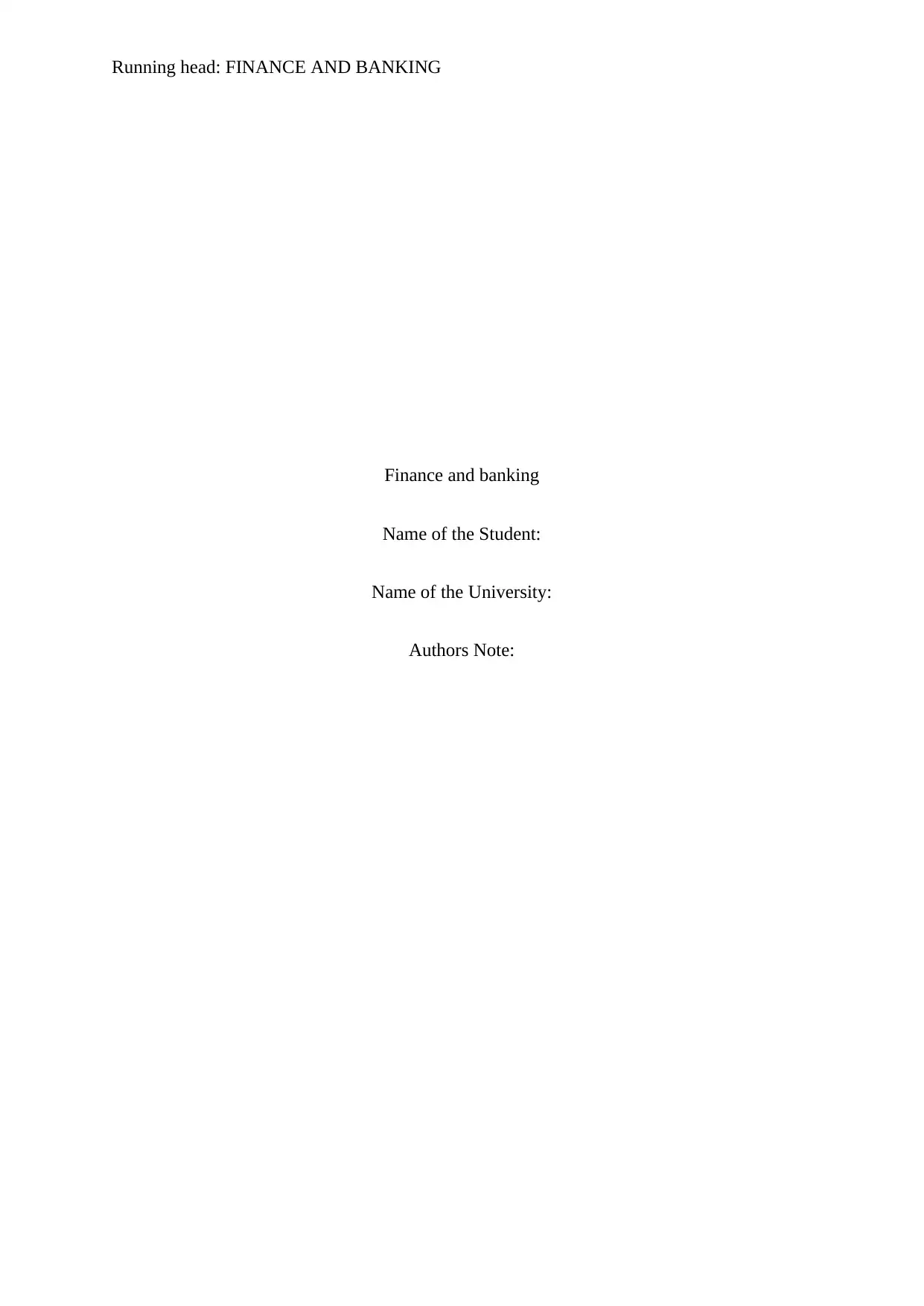
Running head: FINANCE AND BANKING
Finance and banking
Name of the Student:
Name of the University:
Authors Note:
Finance and banking
Name of the Student:
Name of the University:
Authors Note:
Paraphrase This Document
Need a fresh take? Get an instant paraphrase of this document with our AI Paraphraser

FINANCE AND BANKING
1
Table of Contents
Part A: AMP and CBA Share Price...........................................................................................2
1. Detecting the share price of AMP, NAB and CBA, where adequate explanation is provided
in the past five years with graph and other series:.....................................................................2
2. Indicating share price movement of AMP and CBA due to the reposts of Royal
Commission inquire:..................................................................................................................4
Part B: Capital Budgeting..........................................................................................................5
1. Depicting the difference between the internal rate of return and required rate of return:......5
2. Evaluating the NPV of both projects and stating which should be accepted:........................6
3. Evaluating the IRR and detecting which project should be accepted:...................................7
4. Mentioning the alternation in conclusion if required rate of return is increased to 14%:......7
5. Mentioning the difference in NPV and IRR, while stating the preferred recommendations
by the company:.........................................................................................................................8
Reference and Bibliography:....................................................................................................10
1
Table of Contents
Part A: AMP and CBA Share Price...........................................................................................2
1. Detecting the share price of AMP, NAB and CBA, where adequate explanation is provided
in the past five years with graph and other series:.....................................................................2
2. Indicating share price movement of AMP and CBA due to the reposts of Royal
Commission inquire:..................................................................................................................4
Part B: Capital Budgeting..........................................................................................................5
1. Depicting the difference between the internal rate of return and required rate of return:......5
2. Evaluating the NPV of both projects and stating which should be accepted:........................6
3. Evaluating the IRR and detecting which project should be accepted:...................................7
4. Mentioning the alternation in conclusion if required rate of return is increased to 14%:......7
5. Mentioning the difference in NPV and IRR, while stating the preferred recommendations
by the company:.........................................................................................................................8
Reference and Bibliography:....................................................................................................10
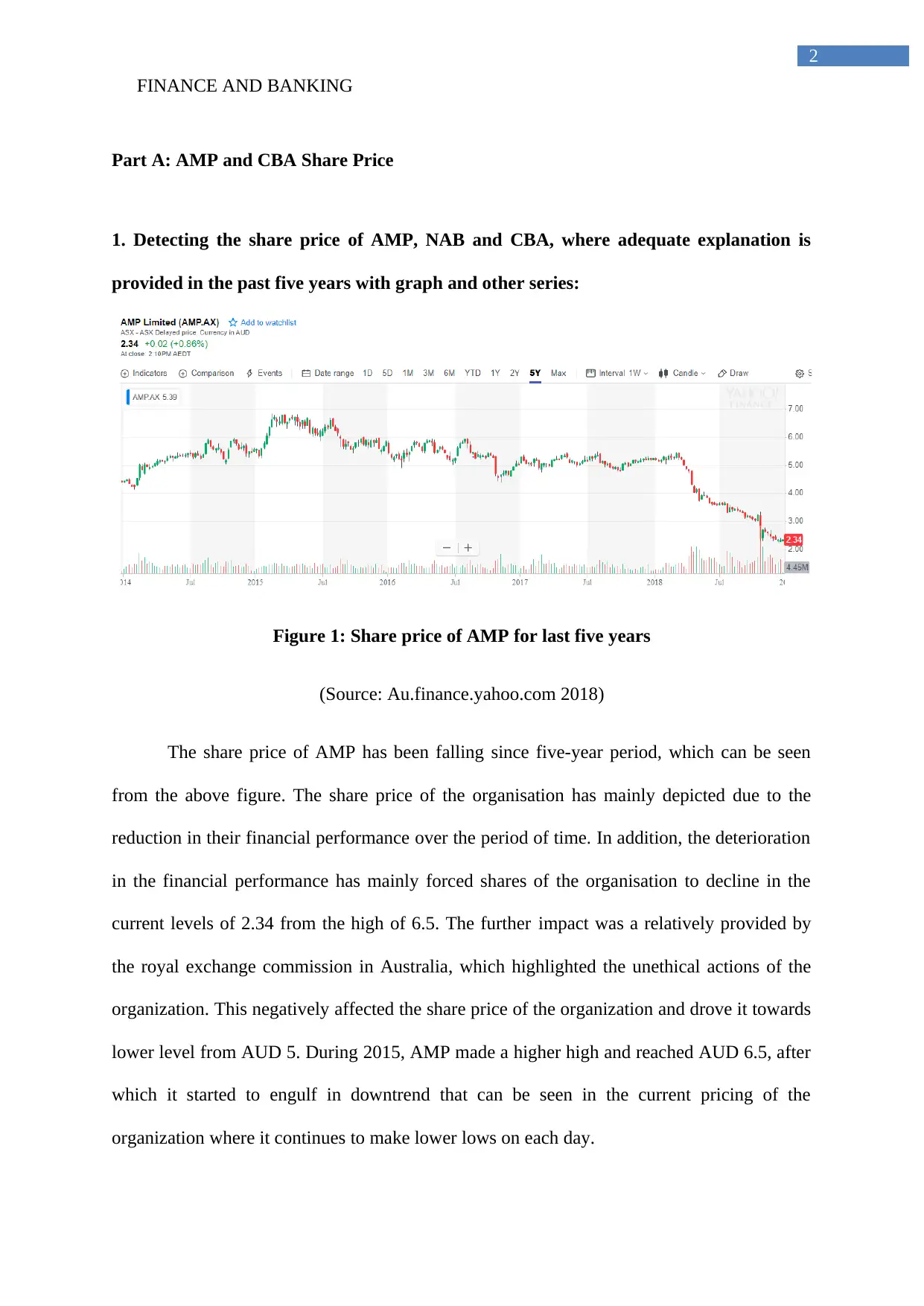
FINANCE AND BANKING
2
Part A: AMP and CBA Share Price
1. Detecting the share price of AMP, NAB and CBA, where adequate explanation is
provided in the past five years with graph and other series:
Figure 1: Share price of AMP for last five years
(Source: Au.finance.yahoo.com 2018)
The share price of AMP has been falling since five-year period, which can be seen
from the above figure. The share price of the organisation has mainly depicted due to the
reduction in their financial performance over the period of time. In addition, the deterioration
in the financial performance has mainly forced shares of the organisation to decline in the
current levels of 2.34 from the high of 6.5. The further impact was a relatively provided by
the royal exchange commission in Australia, which highlighted the unethical actions of the
organization. This negatively affected the share price of the organization and drove it towards
lower level from AUD 5. During 2015, AMP made a higher high and reached AUD 6.5, after
which it started to engulf in downtrend that can be seen in the current pricing of the
organization where it continues to make lower lows on each day.
2
Part A: AMP and CBA Share Price
1. Detecting the share price of AMP, NAB and CBA, where adequate explanation is
provided in the past five years with graph and other series:
Figure 1: Share price of AMP for last five years
(Source: Au.finance.yahoo.com 2018)
The share price of AMP has been falling since five-year period, which can be seen
from the above figure. The share price of the organisation has mainly depicted due to the
reduction in their financial performance over the period of time. In addition, the deterioration
in the financial performance has mainly forced shares of the organisation to decline in the
current levels of 2.34 from the high of 6.5. The further impact was a relatively provided by
the royal exchange commission in Australia, which highlighted the unethical actions of the
organization. This negatively affected the share price of the organization and drove it towards
lower level from AUD 5. During 2015, AMP made a higher high and reached AUD 6.5, after
which it started to engulf in downtrend that can be seen in the current pricing of the
organization where it continues to make lower lows on each day.
⊘ This is a preview!⊘
Do you want full access?
Subscribe today to unlock all pages.

Trusted by 1+ million students worldwide
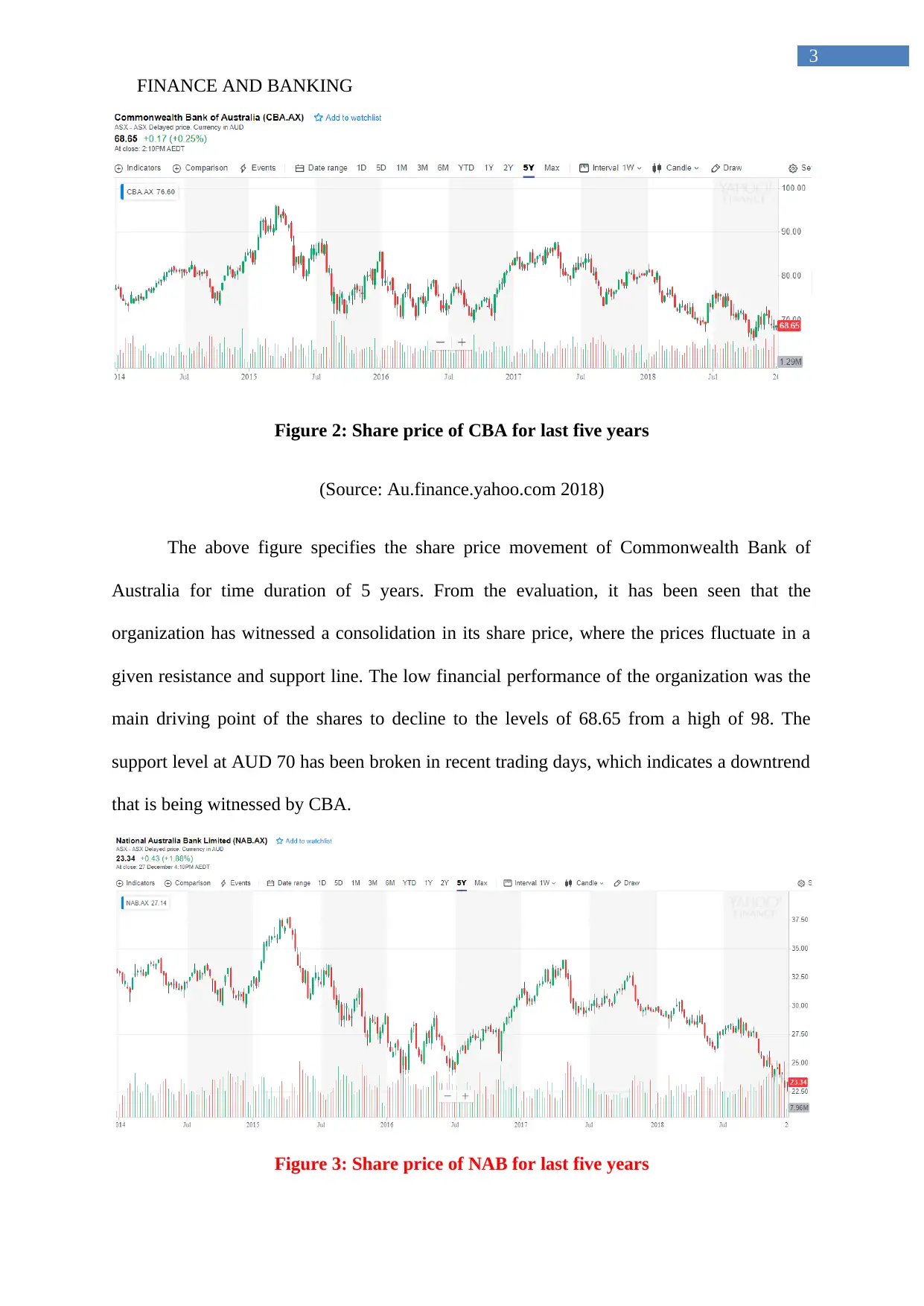
FINANCE AND BANKING
3
Figure 2: Share price of CBA for last five years
(Source: Au.finance.yahoo.com 2018)
The above figure specifies the share price movement of Commonwealth Bank of
Australia for time duration of 5 years. From the evaluation, it has been seen that the
organization has witnessed a consolidation in its share price, where the prices fluctuate in a
given resistance and support line. The low financial performance of the organization was the
main driving point of the shares to decline to the levels of 68.65 from a high of 98. The
support level at AUD 70 has been broken in recent trading days, which indicates a downtrend
that is being witnessed by CBA.
Figure 3: Share price of NAB for last five years
3
Figure 2: Share price of CBA for last five years
(Source: Au.finance.yahoo.com 2018)
The above figure specifies the share price movement of Commonwealth Bank of
Australia for time duration of 5 years. From the evaluation, it has been seen that the
organization has witnessed a consolidation in its share price, where the prices fluctuate in a
given resistance and support line. The low financial performance of the organization was the
main driving point of the shares to decline to the levels of 68.65 from a high of 98. The
support level at AUD 70 has been broken in recent trading days, which indicates a downtrend
that is being witnessed by CBA.
Figure 3: Share price of NAB for last five years
Paraphrase This Document
Need a fresh take? Get an instant paraphrase of this document with our AI Paraphraser

FINANCE AND BANKING
4
(Source: Au.finance.yahoo.com 2018)
The share price of the organisation has mainly declined over the period of five years,
which is due to the lack in financial performance and the report of the royal commission. The
share price is in downtrend, where it is making lower lows in each trading day. The highest
value of NAB was at the levels of 37.78, while the lowest value during the five-year period is
at 22.52.
2. Indicating share price movement of AMP and CBA due to the reposts of Royal
Commission inquire:
The royal Commission of Australia was assigned to identify the loopholes and
misconduct that in the operations of major financial bank in the country. This permission has
completed their work by identifying certain actions and measures that has been taken by the
financial banking sectors of Australia, which was not in lieu with the regulations laid down
by the regulators. Report of Royal Commission has infused the market with high systematic
risk and unsystematic risk, as it raised the uncertainty in investors regarding the ethical
actions taken by the organizations. The royal Commission was directly appointed for
identifying the malpractices of financial banks in Australia and detects the problems that
were hampering the citizens of the country (Theguardian.com 2018).
Moreover, the royal Commission has been providing certain news regarding the
manipulations that has been conducted by both AMP and CBA, which has reflected
negatively on their share price. Royal Commission also highlighted the high charging fees
that were implemented by AMP for super accounts, which was considered unethical and
forced the organization to pay AUD 5 million as compensation to almost 50,000
superannuation fund members. Royal Commission also highlighted the problems and
unethical measures that were being used by Commonwealth Bank of Australia, which was to
4
(Source: Au.finance.yahoo.com 2018)
The share price of the organisation has mainly declined over the period of five years,
which is due to the lack in financial performance and the report of the royal commission. The
share price is in downtrend, where it is making lower lows in each trading day. The highest
value of NAB was at the levels of 37.78, while the lowest value during the five-year period is
at 22.52.
2. Indicating share price movement of AMP and CBA due to the reposts of Royal
Commission inquire:
The royal Commission of Australia was assigned to identify the loopholes and
misconduct that in the operations of major financial bank in the country. This permission has
completed their work by identifying certain actions and measures that has been taken by the
financial banking sectors of Australia, which was not in lieu with the regulations laid down
by the regulators. Report of Royal Commission has infused the market with high systematic
risk and unsystematic risk, as it raised the uncertainty in investors regarding the ethical
actions taken by the organizations. The royal Commission was directly appointed for
identifying the malpractices of financial banks in Australia and detects the problems that
were hampering the citizens of the country (Theguardian.com 2018).
Moreover, the royal Commission has been providing certain news regarding the
manipulations that has been conducted by both AMP and CBA, which has reflected
negatively on their share price. Royal Commission also highlighted the high charging fees
that were implemented by AMP for super accounts, which was considered unethical and
forced the organization to pay AUD 5 million as compensation to almost 50,000
superannuation fund members. Royal Commission also highlighted the problems and
unethical measures that were being used by Commonwealth Bank of Australia, which was to
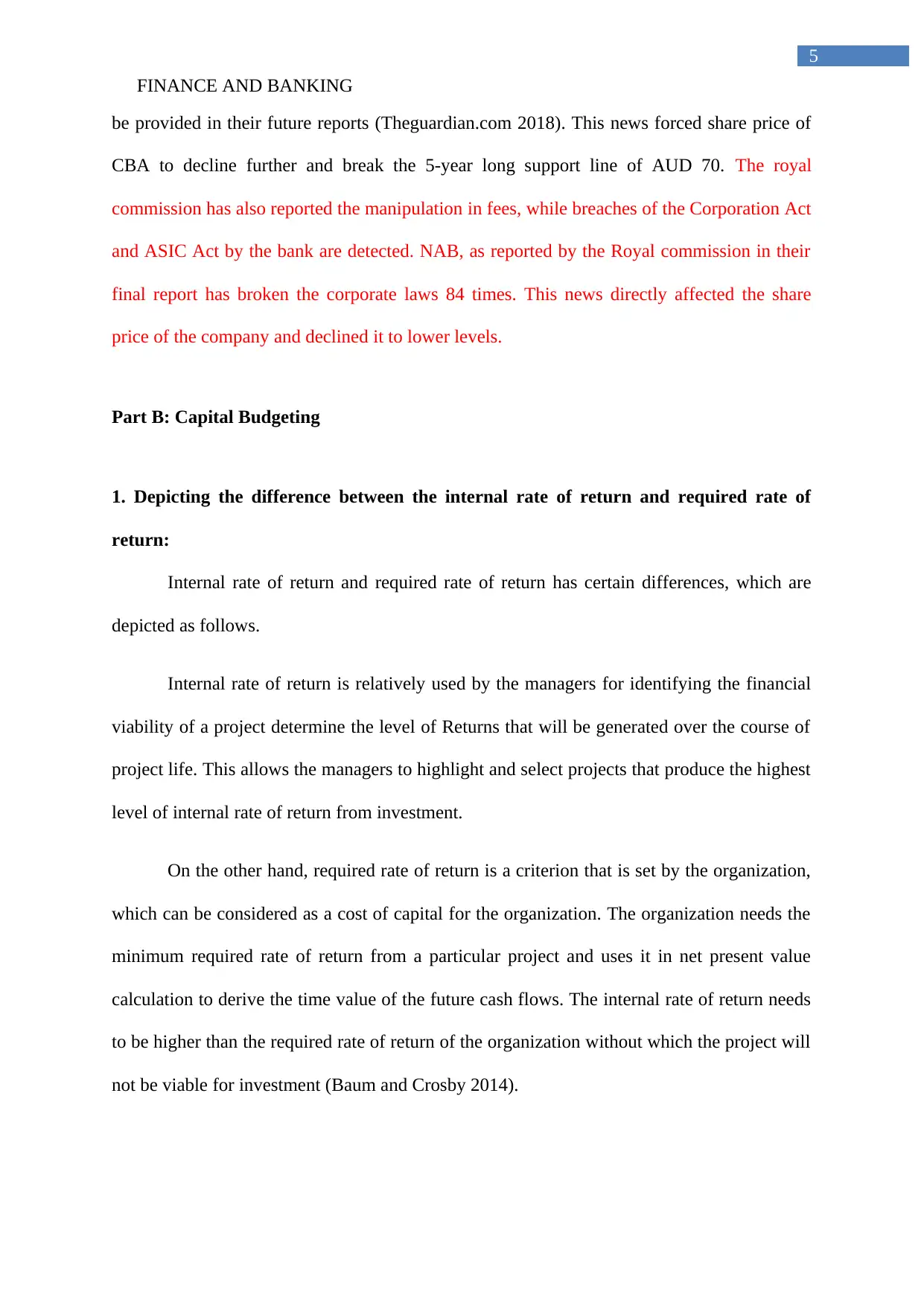
FINANCE AND BANKING
5
be provided in their future reports (Theguardian.com 2018). This news forced share price of
CBA to decline further and break the 5-year long support line of AUD 70. The royal
commission has also reported the manipulation in fees, while breaches of the Corporation Act
and ASIC Act by the bank are detected. NAB, as reported by the Royal commission in their
final report has broken the corporate laws 84 times. This news directly affected the share
price of the company and declined it to lower levels.
Part B: Capital Budgeting
1. Depicting the difference between the internal rate of return and required rate of
return:
Internal rate of return and required rate of return has certain differences, which are
depicted as follows.
Internal rate of return is relatively used by the managers for identifying the financial
viability of a project determine the level of Returns that will be generated over the course of
project life. This allows the managers to highlight and select projects that produce the highest
level of internal rate of return from investment.
On the other hand, required rate of return is a criterion that is set by the organization,
which can be considered as a cost of capital for the organization. The organization needs the
minimum required rate of return from a particular project and uses it in net present value
calculation to derive the time value of the future cash flows. The internal rate of return needs
to be higher than the required rate of return of the organization without which the project will
not be viable for investment (Baum and Crosby 2014).
5
be provided in their future reports (Theguardian.com 2018). This news forced share price of
CBA to decline further and break the 5-year long support line of AUD 70. The royal
commission has also reported the manipulation in fees, while breaches of the Corporation Act
and ASIC Act by the bank are detected. NAB, as reported by the Royal commission in their
final report has broken the corporate laws 84 times. This news directly affected the share
price of the company and declined it to lower levels.
Part B: Capital Budgeting
1. Depicting the difference between the internal rate of return and required rate of
return:
Internal rate of return and required rate of return has certain differences, which are
depicted as follows.
Internal rate of return is relatively used by the managers for identifying the financial
viability of a project determine the level of Returns that will be generated over the course of
project life. This allows the managers to highlight and select projects that produce the highest
level of internal rate of return from investment.
On the other hand, required rate of return is a criterion that is set by the organization,
which can be considered as a cost of capital for the organization. The organization needs the
minimum required rate of return from a particular project and uses it in net present value
calculation to derive the time value of the future cash flows. The internal rate of return needs
to be higher than the required rate of return of the organization without which the project will
not be viable for investment (Baum and Crosby 2014).
⊘ This is a preview!⊘
Do you want full access?
Subscribe today to unlock all pages.

Trusted by 1+ million students worldwide
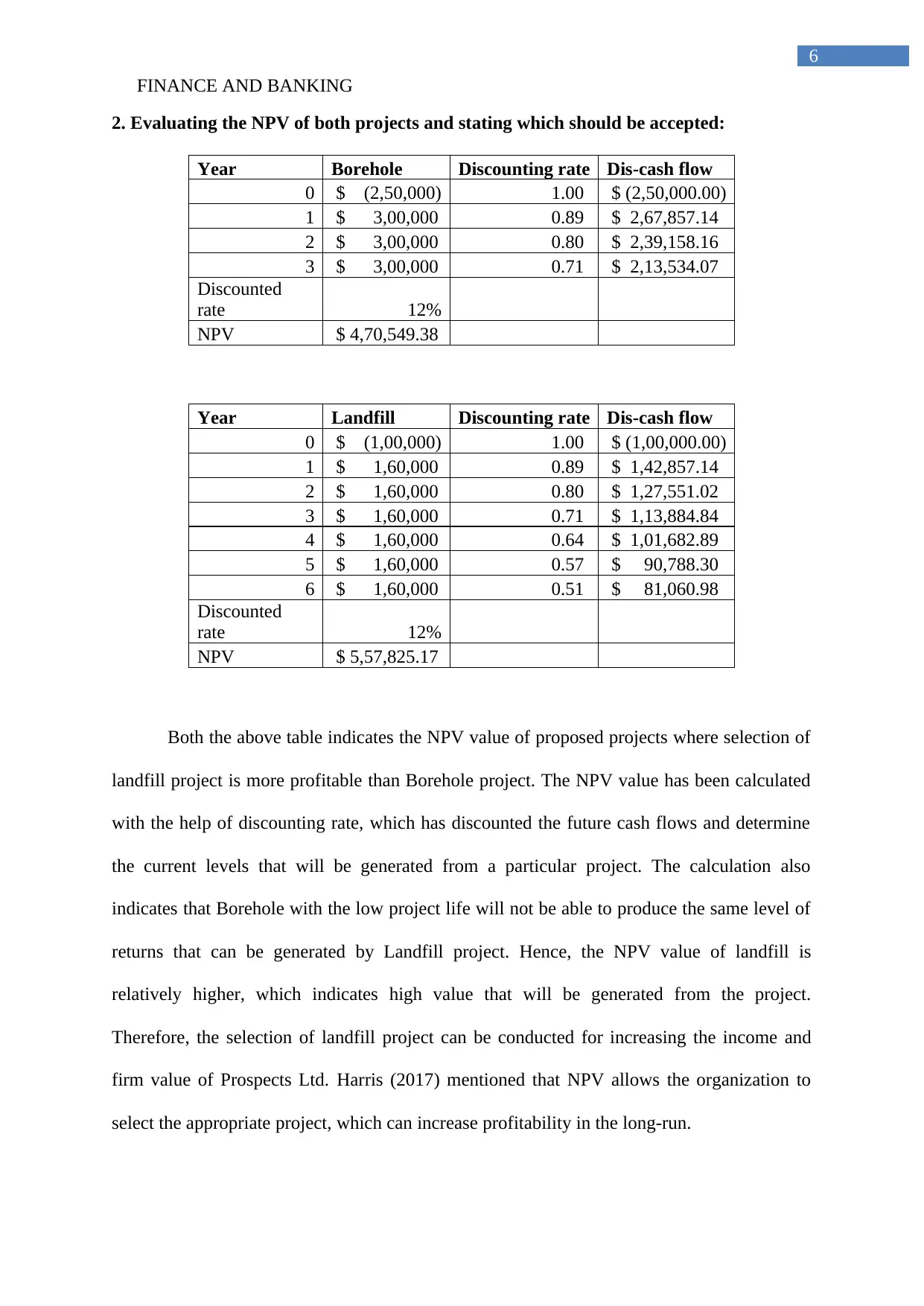
FINANCE AND BANKING
6
2. Evaluating the NPV of both projects and stating which should be accepted:
Year Borehole Discounting rate Dis-cash flow
0 $ (2,50,000) 1.00 $ (2,50,000.00)
1 $ 3,00,000 0.89 $ 2,67,857.14
2 $ 3,00,000 0.80 $ 2,39,158.16
3 $ 3,00,000 0.71 $ 2,13,534.07
Discounted
rate 12%
NPV $ 4,70,549.38
Year Landfill Discounting rate Dis-cash flow
0 $ (1,00,000) 1.00 $ (1,00,000.00)
1 $ 1,60,000 0.89 $ 1,42,857.14
2 $ 1,60,000 0.80 $ 1,27,551.02
3 $ 1,60,000 0.71 $ 1,13,884.84
4 $ 1,60,000 0.64 $ 1,01,682.89
5 $ 1,60,000 0.57 $ 90,788.30
6 $ 1,60,000 0.51 $ 81,060.98
Discounted
rate 12%
NPV $ 5,57,825.17
Both the above table indicates the NPV value of proposed projects where selection of
landfill project is more profitable than Borehole project. The NPV value has been calculated
with the help of discounting rate, which has discounted the future cash flows and determine
the current levels that will be generated from a particular project. The calculation also
indicates that Borehole with the low project life will not be able to produce the same level of
returns that can be generated by Landfill project. Hence, the NPV value of landfill is
relatively higher, which indicates high value that will be generated from the project.
Therefore, the selection of landfill project can be conducted for increasing the income and
firm value of Prospects Ltd. Harris (2017) mentioned that NPV allows the organization to
select the appropriate project, which can increase profitability in the long-run.
6
2. Evaluating the NPV of both projects and stating which should be accepted:
Year Borehole Discounting rate Dis-cash flow
0 $ (2,50,000) 1.00 $ (2,50,000.00)
1 $ 3,00,000 0.89 $ 2,67,857.14
2 $ 3,00,000 0.80 $ 2,39,158.16
3 $ 3,00,000 0.71 $ 2,13,534.07
Discounted
rate 12%
NPV $ 4,70,549.38
Year Landfill Discounting rate Dis-cash flow
0 $ (1,00,000) 1.00 $ (1,00,000.00)
1 $ 1,60,000 0.89 $ 1,42,857.14
2 $ 1,60,000 0.80 $ 1,27,551.02
3 $ 1,60,000 0.71 $ 1,13,884.84
4 $ 1,60,000 0.64 $ 1,01,682.89
5 $ 1,60,000 0.57 $ 90,788.30
6 $ 1,60,000 0.51 $ 81,060.98
Discounted
rate 12%
NPV $ 5,57,825.17
Both the above table indicates the NPV value of proposed projects where selection of
landfill project is more profitable than Borehole project. The NPV value has been calculated
with the help of discounting rate, which has discounted the future cash flows and determine
the current levels that will be generated from a particular project. The calculation also
indicates that Borehole with the low project life will not be able to produce the same level of
returns that can be generated by Landfill project. Hence, the NPV value of landfill is
relatively higher, which indicates high value that will be generated from the project.
Therefore, the selection of landfill project can be conducted for increasing the income and
firm value of Prospects Ltd. Harris (2017) mentioned that NPV allows the organization to
select the appropriate project, which can increase profitability in the long-run.
Paraphrase This Document
Need a fresh take? Get an instant paraphrase of this document with our AI Paraphraser
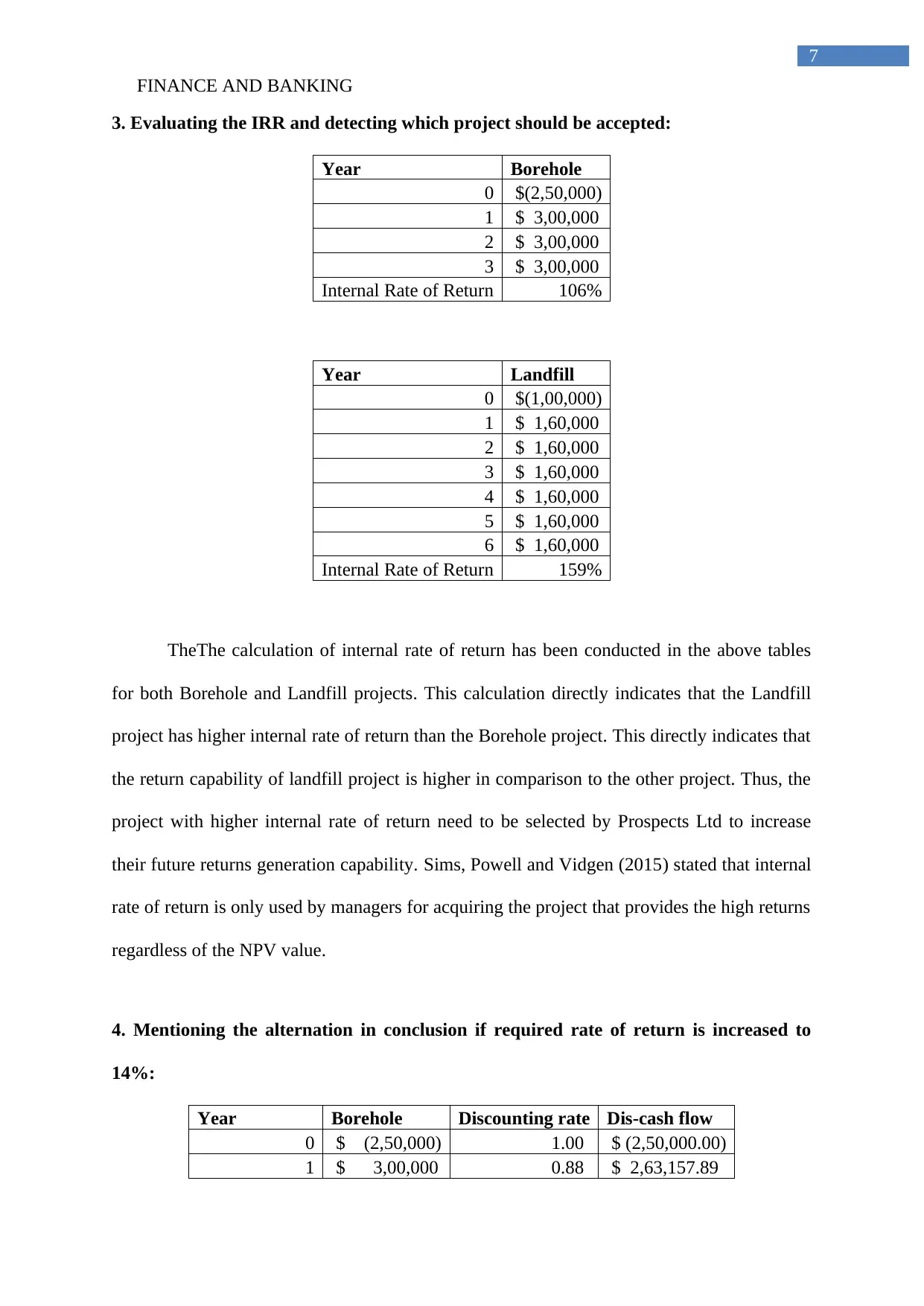
FINANCE AND BANKING
7
3. Evaluating the IRR and detecting which project should be accepted:
Year Borehole
0 $(2,50,000)
1 $ 3,00,000
2 $ 3,00,000
3 $ 3,00,000
Internal Rate of Return 106%
Year Landfill
0 $(1,00,000)
1 $ 1,60,000
2 $ 1,60,000
3 $ 1,60,000
4 $ 1,60,000
5 $ 1,60,000
6 $ 1,60,000
Internal Rate of Return 159%
TheThe calculation of internal rate of return has been conducted in the above tables
for both Borehole and Landfill projects. This calculation directly indicates that the Landfill
project has higher internal rate of return than the Borehole project. This directly indicates that
the return capability of landfill project is higher in comparison to the other project. Thus, the
project with higher internal rate of return need to be selected by Prospects Ltd to increase
their future returns generation capability. Sims, Powell and Vidgen (2015) stated that internal
rate of return is only used by managers for acquiring the project that provides the high returns
regardless of the NPV value.
4. Mentioning the alternation in conclusion if required rate of return is increased to
14%:
Year Borehole Discounting rate Dis-cash flow
0 $ (2,50,000) 1.00 $ (2,50,000.00)
1 $ 3,00,000 0.88 $ 2,63,157.89
7
3. Evaluating the IRR and detecting which project should be accepted:
Year Borehole
0 $(2,50,000)
1 $ 3,00,000
2 $ 3,00,000
3 $ 3,00,000
Internal Rate of Return 106%
Year Landfill
0 $(1,00,000)
1 $ 1,60,000
2 $ 1,60,000
3 $ 1,60,000
4 $ 1,60,000
5 $ 1,60,000
6 $ 1,60,000
Internal Rate of Return 159%
TheThe calculation of internal rate of return has been conducted in the above tables
for both Borehole and Landfill projects. This calculation directly indicates that the Landfill
project has higher internal rate of return than the Borehole project. This directly indicates that
the return capability of landfill project is higher in comparison to the other project. Thus, the
project with higher internal rate of return need to be selected by Prospects Ltd to increase
their future returns generation capability. Sims, Powell and Vidgen (2015) stated that internal
rate of return is only used by managers for acquiring the project that provides the high returns
regardless of the NPV value.
4. Mentioning the alternation in conclusion if required rate of return is increased to
14%:
Year Borehole Discounting rate Dis-cash flow
0 $ (2,50,000) 1.00 $ (2,50,000.00)
1 $ 3,00,000 0.88 $ 2,63,157.89
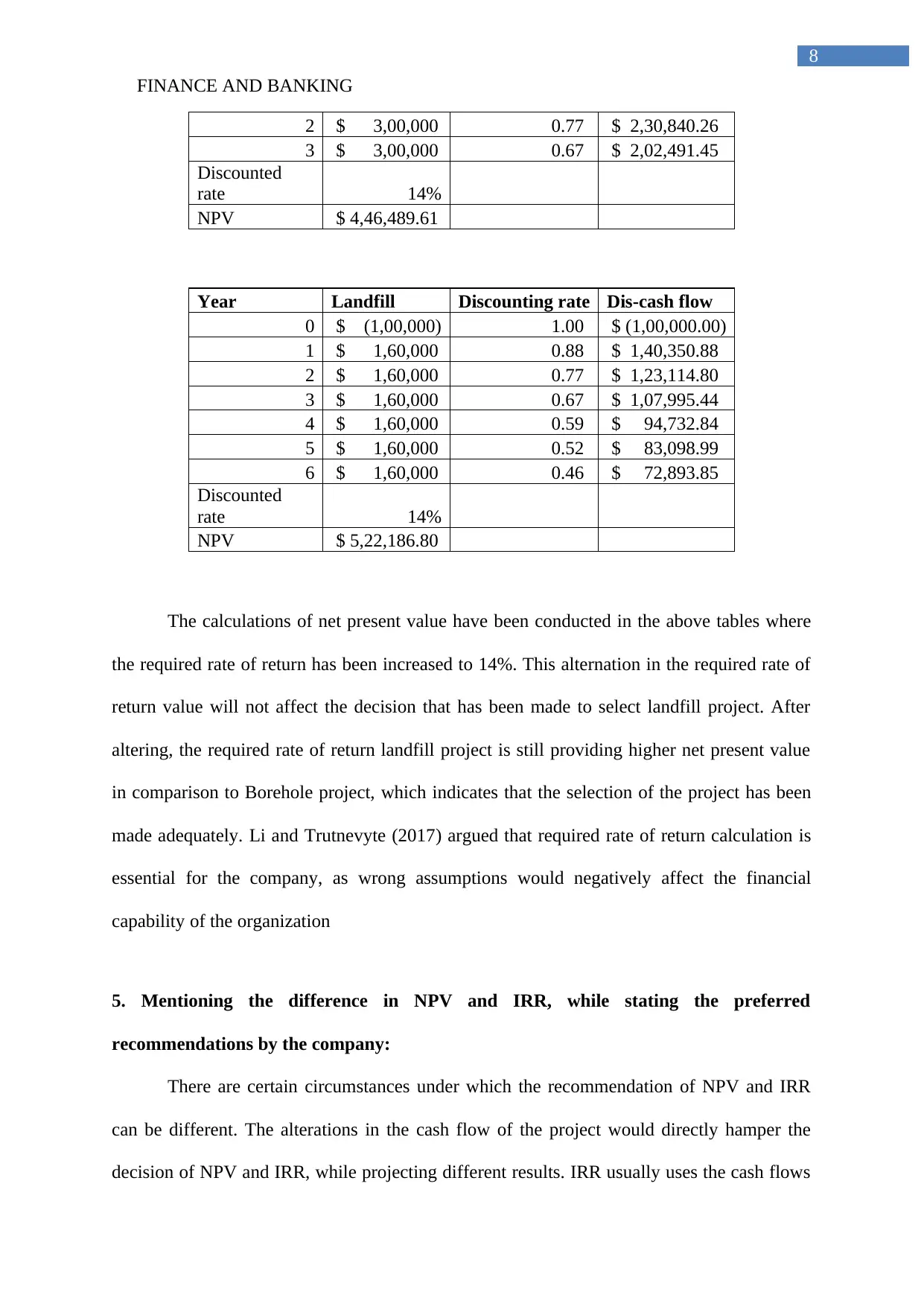
FINANCE AND BANKING
8
2 $ 3,00,000 0.77 $ 2,30,840.26
3 $ 3,00,000 0.67 $ 2,02,491.45
Discounted
rate 14%
NPV $ 4,46,489.61
Year Landfill Discounting rate Dis-cash flow
0 $ (1,00,000) 1.00 $ (1,00,000.00)
1 $ 1,60,000 0.88 $ 1,40,350.88
2 $ 1,60,000 0.77 $ 1,23,114.80
3 $ 1,60,000 0.67 $ 1,07,995.44
4 $ 1,60,000 0.59 $ 94,732.84
5 $ 1,60,000 0.52 $ 83,098.99
6 $ 1,60,000 0.46 $ 72,893.85
Discounted
rate 14%
NPV $ 5,22,186.80
The calculations of net present value have been conducted in the above tables where
the required rate of return has been increased to 14%. This alternation in the required rate of
return value will not affect the decision that has been made to select landfill project. After
altering, the required rate of return landfill project is still providing higher net present value
in comparison to Borehole project, which indicates that the selection of the project has been
made adequately. Li and Trutnevyte (2017) argued that required rate of return calculation is
essential for the company, as wrong assumptions would negatively affect the financial
capability of the organization
5. Mentioning the difference in NPV and IRR, while stating the preferred
recommendations by the company:
There are certain circumstances under which the recommendation of NPV and IRR
can be different. The alterations in the cash flow of the project would directly hamper the
decision of NPV and IRR, while projecting different results. IRR usually uses the cash flows
8
2 $ 3,00,000 0.77 $ 2,30,840.26
3 $ 3,00,000 0.67 $ 2,02,491.45
Discounted
rate 14%
NPV $ 4,46,489.61
Year Landfill Discounting rate Dis-cash flow
0 $ (1,00,000) 1.00 $ (1,00,000.00)
1 $ 1,60,000 0.88 $ 1,40,350.88
2 $ 1,60,000 0.77 $ 1,23,114.80
3 $ 1,60,000 0.67 $ 1,07,995.44
4 $ 1,60,000 0.59 $ 94,732.84
5 $ 1,60,000 0.52 $ 83,098.99
6 $ 1,60,000 0.46 $ 72,893.85
Discounted
rate 14%
NPV $ 5,22,186.80
The calculations of net present value have been conducted in the above tables where
the required rate of return has been increased to 14%. This alternation in the required rate of
return value will not affect the decision that has been made to select landfill project. After
altering, the required rate of return landfill project is still providing higher net present value
in comparison to Borehole project, which indicates that the selection of the project has been
made adequately. Li and Trutnevyte (2017) argued that required rate of return calculation is
essential for the company, as wrong assumptions would negatively affect the financial
capability of the organization
5. Mentioning the difference in NPV and IRR, while stating the preferred
recommendations by the company:
There are certain circumstances under which the recommendation of NPV and IRR
can be different. The alterations in the cash flow of the project would directly hamper the
decision of NPV and IRR, while projecting different results. IRR usually uses the cash flows
⊘ This is a preview!⊘
Do you want full access?
Subscribe today to unlock all pages.

Trusted by 1+ million students worldwide
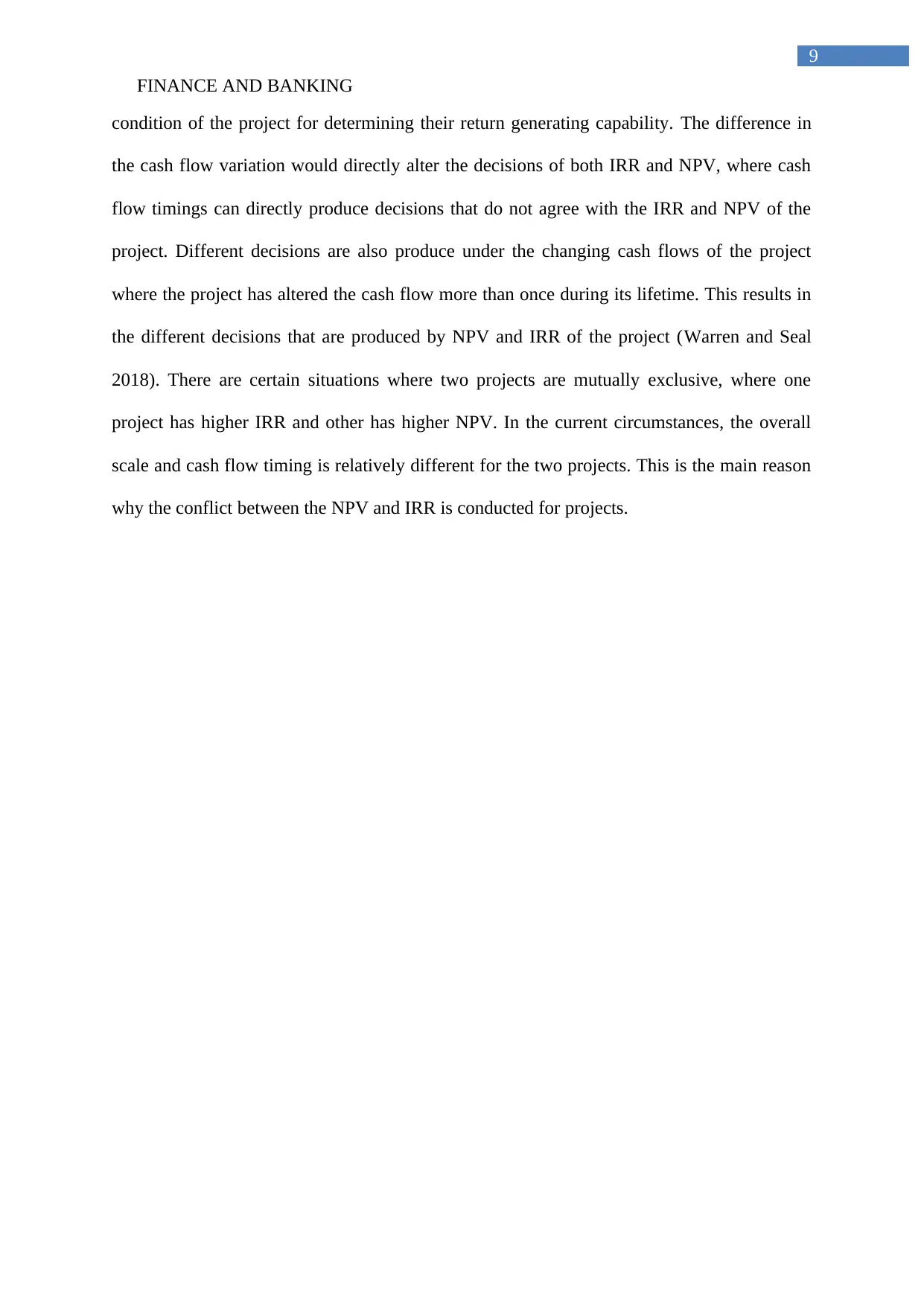
FINANCE AND BANKING
9
condition of the project for determining their return generating capability. The difference in
the cash flow variation would directly alter the decisions of both IRR and NPV, where cash
flow timings can directly produce decisions that do not agree with the IRR and NPV of the
project. Different decisions are also produce under the changing cash flows of the project
where the project has altered the cash flow more than once during its lifetime. This results in
the different decisions that are produced by NPV and IRR of the project (Warren and Seal
2018). There are certain situations where two projects are mutually exclusive, where one
project has higher IRR and other has higher NPV. In the current circumstances, the overall
scale and cash flow timing is relatively different for the two projects. This is the main reason
why the conflict between the NPV and IRR is conducted for projects.
9
condition of the project for determining their return generating capability. The difference in
the cash flow variation would directly alter the decisions of both IRR and NPV, where cash
flow timings can directly produce decisions that do not agree with the IRR and NPV of the
project. Different decisions are also produce under the changing cash flows of the project
where the project has altered the cash flow more than once during its lifetime. This results in
the different decisions that are produced by NPV and IRR of the project (Warren and Seal
2018). There are certain situations where two projects are mutually exclusive, where one
project has higher IRR and other has higher NPV. In the current circumstances, the overall
scale and cash flow timing is relatively different for the two projects. This is the main reason
why the conflict between the NPV and IRR is conducted for projects.
Paraphrase This Document
Need a fresh take? Get an instant paraphrase of this document with our AI Paraphraser
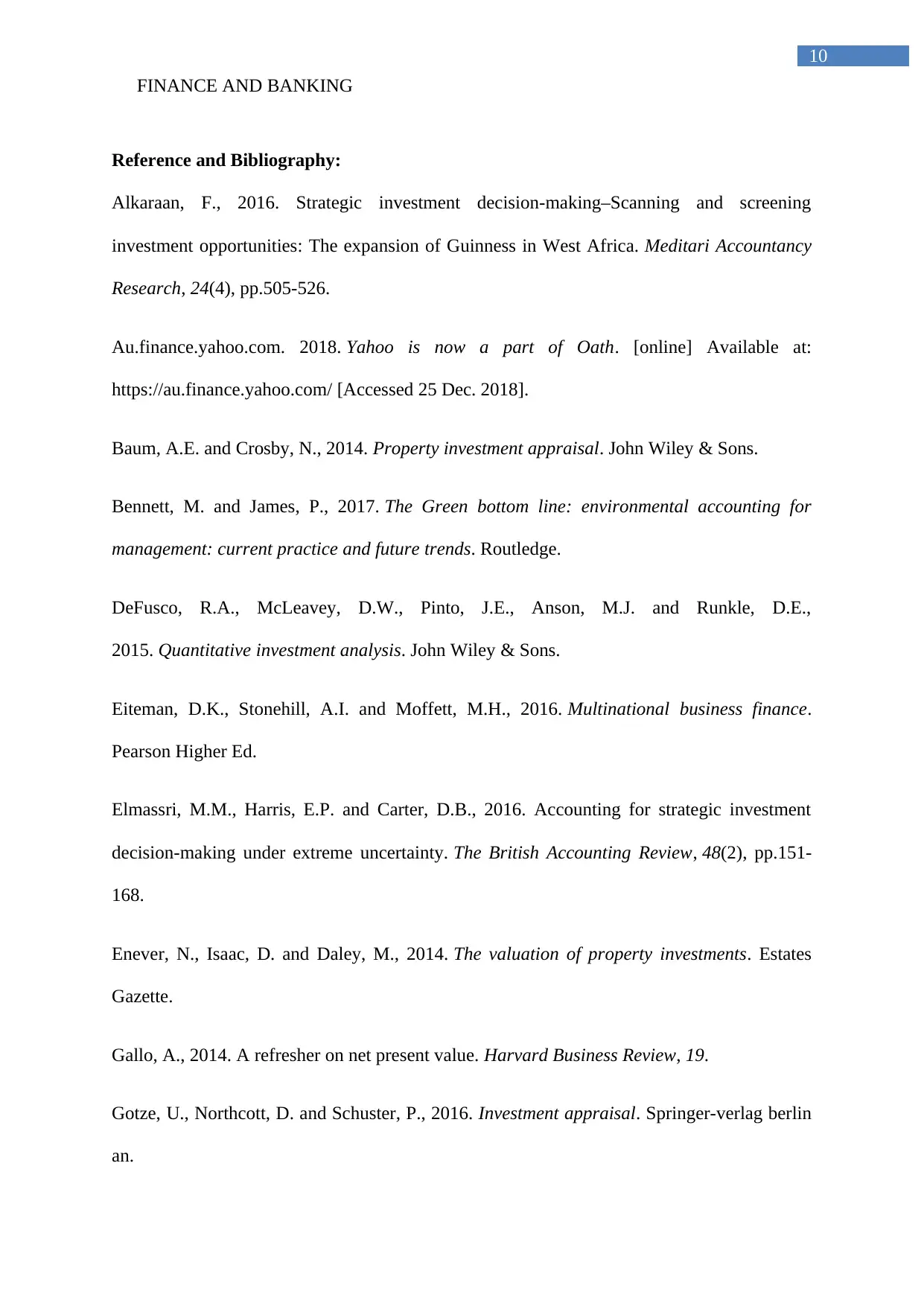
FINANCE AND BANKING
10
Reference and Bibliography:
Alkaraan, F., 2016. Strategic investment decision-making–Scanning and screening
investment opportunities: The expansion of Guinness in West Africa. Meditari Accountancy
Research, 24(4), pp.505-526.
Au.finance.yahoo.com. 2018. Yahoo is now a part of Oath. [online] Available at:
https://au.finance.yahoo.com/ [Accessed 25 Dec. 2018].
Baum, A.E. and Crosby, N., 2014. Property investment appraisal. John Wiley & Sons.
Bennett, M. and James, P., 2017. The Green bottom line: environmental accounting for
management: current practice and future trends. Routledge.
DeFusco, R.A., McLeavey, D.W., Pinto, J.E., Anson, M.J. and Runkle, D.E.,
2015. Quantitative investment analysis. John Wiley & Sons.
Eiteman, D.K., Stonehill, A.I. and Moffett, M.H., 2016. Multinational business finance.
Pearson Higher Ed.
Elmassri, M.M., Harris, E.P. and Carter, D.B., 2016. Accounting for strategic investment
decision-making under extreme uncertainty. The British Accounting Review, 48(2), pp.151-
168.
Enever, N., Isaac, D. and Daley, M., 2014. The valuation of property investments. Estates
Gazette.
Gallo, A., 2014. A refresher on net present value. Harvard Business Review, 19.
Gotze, U., Northcott, D. and Schuster, P., 2016. Investment appraisal. Springer-verlag berlin
an.
10
Reference and Bibliography:
Alkaraan, F., 2016. Strategic investment decision-making–Scanning and screening
investment opportunities: The expansion of Guinness in West Africa. Meditari Accountancy
Research, 24(4), pp.505-526.
Au.finance.yahoo.com. 2018. Yahoo is now a part of Oath. [online] Available at:
https://au.finance.yahoo.com/ [Accessed 25 Dec. 2018].
Baum, A.E. and Crosby, N., 2014. Property investment appraisal. John Wiley & Sons.
Bennett, M. and James, P., 2017. The Green bottom line: environmental accounting for
management: current practice and future trends. Routledge.
DeFusco, R.A., McLeavey, D.W., Pinto, J.E., Anson, M.J. and Runkle, D.E.,
2015. Quantitative investment analysis. John Wiley & Sons.
Eiteman, D.K., Stonehill, A.I. and Moffett, M.H., 2016. Multinational business finance.
Pearson Higher Ed.
Elmassri, M.M., Harris, E.P. and Carter, D.B., 2016. Accounting for strategic investment
decision-making under extreme uncertainty. The British Accounting Review, 48(2), pp.151-
168.
Enever, N., Isaac, D. and Daley, M., 2014. The valuation of property investments. Estates
Gazette.
Gallo, A., 2014. A refresher on net present value. Harvard Business Review, 19.
Gotze, U., Northcott, D. and Schuster, P., 2016. Investment appraisal. Springer-verlag berlin
an.
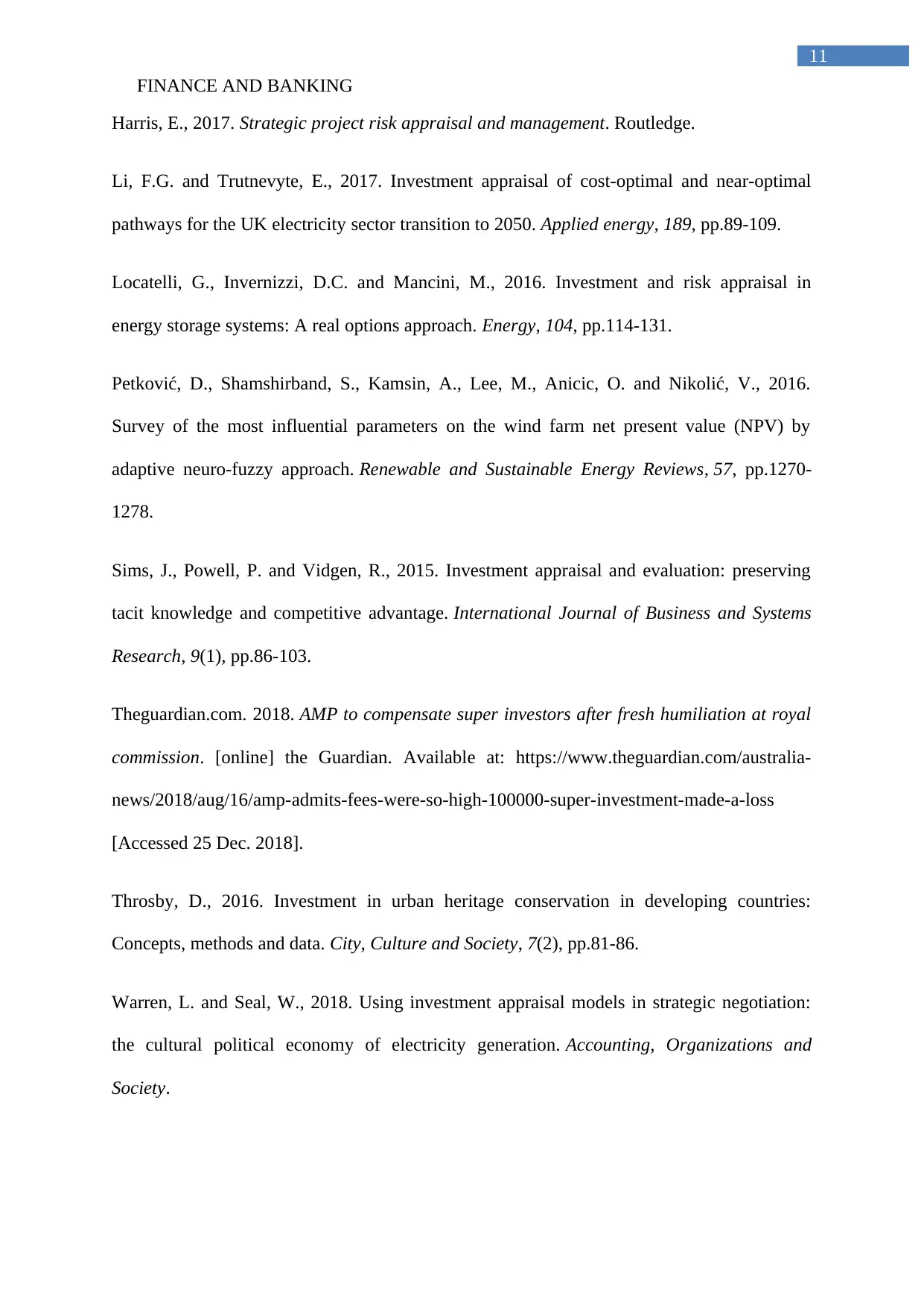
FINANCE AND BANKING
11
Harris, E., 2017. Strategic project risk appraisal and management. Routledge.
Li, F.G. and Trutnevyte, E., 2017. Investment appraisal of cost-optimal and near-optimal
pathways for the UK electricity sector transition to 2050. Applied energy, 189, pp.89-109.
Locatelli, G., Invernizzi, D.C. and Mancini, M., 2016. Investment and risk appraisal in
energy storage systems: A real options approach. Energy, 104, pp.114-131.
Petković, D., Shamshirband, S., Kamsin, A., Lee, M., Anicic, O. and Nikolić, V., 2016.
Survey of the most influential parameters on the wind farm net present value (NPV) by
adaptive neuro-fuzzy approach. Renewable and Sustainable Energy Reviews, 57, pp.1270-
1278.
Sims, J., Powell, P. and Vidgen, R., 2015. Investment appraisal and evaluation: preserving
tacit knowledge and competitive advantage. International Journal of Business and Systems
Research, 9(1), pp.86-103.
Theguardian.com. 2018. AMP to compensate super investors after fresh humiliation at royal
commission. [online] the Guardian. Available at: https://www.theguardian.com/australia-
news/2018/aug/16/amp-admits-fees-were-so-high-100000-super-investment-made-a-loss
[Accessed 25 Dec. 2018].
Throsby, D., 2016. Investment in urban heritage conservation in developing countries:
Concepts, methods and data. City, Culture and Society, 7(2), pp.81-86.
Warren, L. and Seal, W., 2018. Using investment appraisal models in strategic negotiation:
the cultural political economy of electricity generation. Accounting, Organizations and
Society.
11
Harris, E., 2017. Strategic project risk appraisal and management. Routledge.
Li, F.G. and Trutnevyte, E., 2017. Investment appraisal of cost-optimal and near-optimal
pathways for the UK electricity sector transition to 2050. Applied energy, 189, pp.89-109.
Locatelli, G., Invernizzi, D.C. and Mancini, M., 2016. Investment and risk appraisal in
energy storage systems: A real options approach. Energy, 104, pp.114-131.
Petković, D., Shamshirband, S., Kamsin, A., Lee, M., Anicic, O. and Nikolić, V., 2016.
Survey of the most influential parameters on the wind farm net present value (NPV) by
adaptive neuro-fuzzy approach. Renewable and Sustainable Energy Reviews, 57, pp.1270-
1278.
Sims, J., Powell, P. and Vidgen, R., 2015. Investment appraisal and evaluation: preserving
tacit knowledge and competitive advantage. International Journal of Business and Systems
Research, 9(1), pp.86-103.
Theguardian.com. 2018. AMP to compensate super investors after fresh humiliation at royal
commission. [online] the Guardian. Available at: https://www.theguardian.com/australia-
news/2018/aug/16/amp-admits-fees-were-so-high-100000-super-investment-made-a-loss
[Accessed 25 Dec. 2018].
Throsby, D., 2016. Investment in urban heritage conservation in developing countries:
Concepts, methods and data. City, Culture and Society, 7(2), pp.81-86.
Warren, L. and Seal, W., 2018. Using investment appraisal models in strategic negotiation:
the cultural political economy of electricity generation. Accounting, Organizations and
Society.
⊘ This is a preview!⊘
Do you want full access?
Subscribe today to unlock all pages.

Trusted by 1+ million students worldwide
1 out of 12
Related Documents
Your All-in-One AI-Powered Toolkit for Academic Success.
+13062052269
info@desklib.com
Available 24*7 on WhatsApp / Email
![[object Object]](/_next/static/media/star-bottom.7253800d.svg)
Unlock your academic potential
Copyright © 2020–2025 A2Z Services. All Rights Reserved. Developed and managed by ZUCOL.





